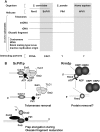Roles of Pif1-like helicases in the maintenance of genomic stability
- PMID: 16935874
- PMCID: PMC1616966
- DOI: 10.1093/nar/gkl561
Roles of Pif1-like helicases in the maintenance of genomic stability
Abstract
The Pif1p family of DNA helicases is conserved from yeast to humans. To date, four members of this family have been analyzed in some detail by in vitro and in vivo assays: the two baker's yeast helicases, ScPif1p and Rrm3p, the fission yeast Pfh1p and the human enzyme hPif1p. In vitro, these enzymes are 5' to 3' DNA helicase and show little processivity. In vivo, ScPif1p, Rrm3p and probably Pfh1p, function in both the nucleus at specific genomic loci and in mitochondria, where they are needed for the stable maintenance of the genome as accessory helicases to the replication machinery. Interestingly, they act on common DNA substrates but appear to have largely non-overlapping cellular functions, ranging from Okazaki fragment processing, telomerase inhibition, to helping the replication fork progress through non-nucleosomal protein-DNA complexes. For example, both ScPif1p and Rrm3p affect the replication of telomeres, but in a different way: Pif1p inhibits telomerase-mediated telomere elongation by directly removing telomerase from a DNA end, whereas Rrm3p facilitates replication through telomeric DNA. Here we review the current knowledge on the Pif1-like helicases, as a first step towards understanding the basis of their functional specialization and mechanism of action.
Figures


References
-
- Krejci L., Van Komen S., Li Y., Villemain J., Reddy M.S., Klein, Ellenberger T., Sung P. DNA helicase Srs2 disrupts the Rad51 presynaptic filament. Nature. 2003;423:305–309. - PubMed
-
- Veaute X., Jeusset J., Soustelle C., Kowalczykowski S.C., Le Cam E., Fabre F. The Srs2 helicase prevents recombination by disrupting Rad51 nucleoprotein filaments. Nature. 2003;423:309–312. - PubMed
-
- Byrd A.K., Raney K.D. Protein displacement by an assembly of helicase molecules aligned along single-stranded DNA. Nat. Struct. Mol. Biol. 2004;11:531–538. - PubMed
-
- Mankouri H.W., Hickson I.D. Understanding the roles of RecQ helicases in the maintenance of genome integrity and suppression of tumorigenesis. Biochem. Soc. Trans. 2004;32:957–958. - PubMed
-
- Cheok C.F., Bachrati C.Z., Chan K.L., Ralf C., Wu L., Hickson I.D. Roles of the Bloom's syndrome helicase in the maintenance of genome stability. Biochem. Soc. Trans. 2005;33:1456–1459. - PubMed
Publication types
MeSH terms
Substances
Grants and funding
LinkOut - more resources
Full Text Sources
Molecular Biology Databases

